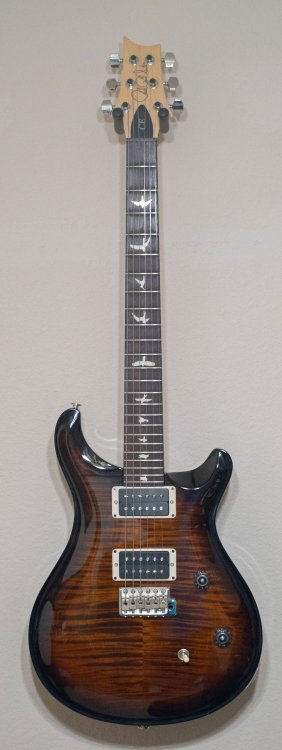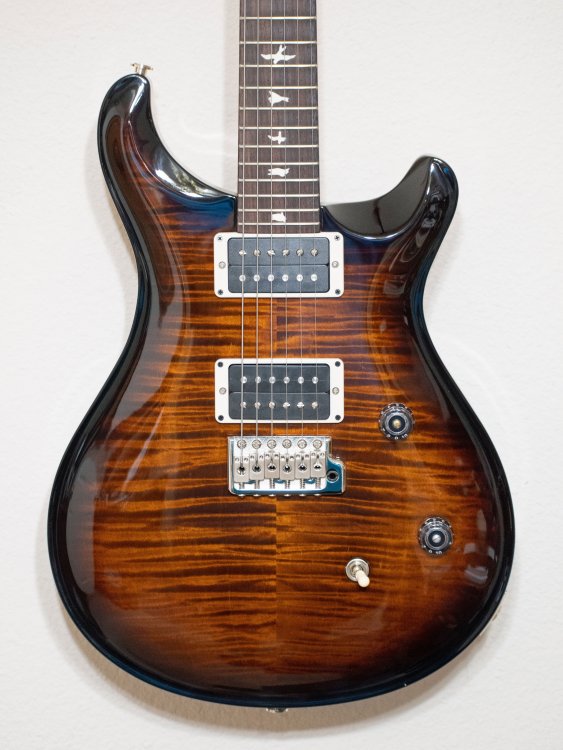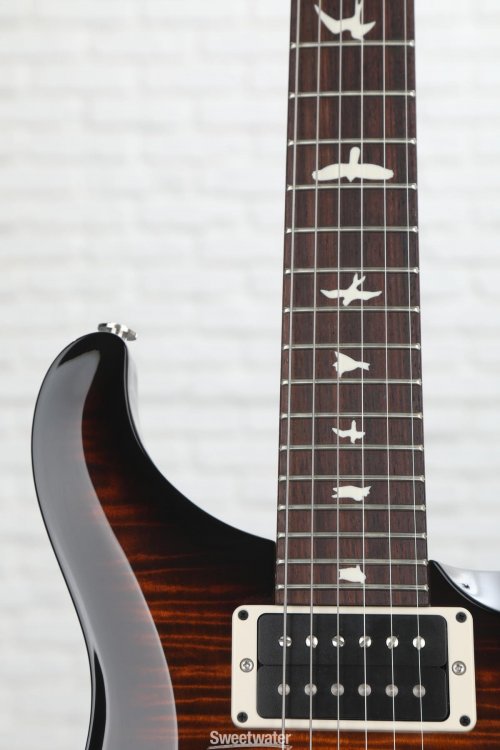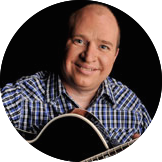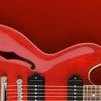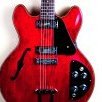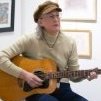-
Posts
192 -
Joined
-
Last visited
-
Days Won
37
Content Type
Profiles
Forums
Gallery
Events
Articles
Blogs
Downloads
Everything posted by Mike Hoodenpyle
-
One of my all-time favorites, and one the main reasons I started playing guitar way back when. I recorded the guitar solo version a few years ago on a tele and posted it on YouTube. Probably need to do it again on an acoustic.
-
Very nice. I have a Breedlove Oregon Concert, all Myrtlewood, that I absolutely love. It's probably the most resonant guitar I've ever played, or a very close second. Enjoy it!
-
I'm not familiar with the progression, but I'm curious as to why the 3rd is eliminated. Also, if you do eliminate the 3rd, the chord is neither major nor minor. You would normally have either a 2nd or 4th in place of the 3rd, making it a sus2 or sus4 chord. If you're only playing the notes F#, C# and E, I don't really know what you would call that, except maybe a C#madd11/F# (no 5).
-
OK, not technically with Laurence Juber, but I thought his performance of "The Pink Panther Theme" was fitting.
- 1 reply
-
- 4
-

-
My understanding has always been a riff is a rhythm figure; a series of chords/notes that repeats throughout the song. A lick is a short series of notes that generally doesn't repeat. Riffs can be strumming patterns and/or arpeggios, and can also include non-chord tone fills, which can make them sound like licks. A turnaround could be either a riff or a lick, and generally returns you to the beginning of a song for the next verse after the chorus. Most (not all) songs end on the I chord, so most choruses also end on the I chord. That being the case, a turnaround would take you from the I chord at the end of a chorus, through a series of other chords and/or notes, and back to the I chord again at the beginning of the song.
-
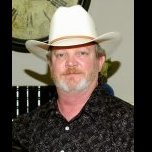
Recording Challenge 82 -🤩 "A little special"☘️
Mike Hoodenpyle replied to Nutty 1's topic in Guitar Playing & Technique
Thanks very much, Greg. Glad you liked it. -

Recording Challenge 82 -🤩 "A little special"☘️
Mike Hoodenpyle replied to Nutty 1's topic in Guitar Playing & Technique
Thanks very much! I use medium gauge, .013 and .017, for the 1st and 2nd strings, and D'Addario EJ-16s (light gauge) for the 3rd thru 6th strings. -

Recording Challenge 82 -🤩 "A little special"☘️
Mike Hoodenpyle replied to Nutty 1's topic in Guitar Playing & Technique
Thanks, Mandy, glad you liked it. -

Recording Challenge 82 -🤩 "A little special"☘️
Mike Hoodenpyle replied to Nutty 1's topic in Guitar Playing & Technique
Here's my attempt at Laurence Juber's "The White Pass Trail." This piece is special for several reasons: 1. It's one of my favorite originals by one of my favorite players. 2. It's in DADGAD tuning. 3. There's a lot going on: hammers, pulls, bends (both subtle and full step), slides, frailing, slap harmonics, percussion, just a little muted rhythm, and a pinch harmonic where the 24th fret would be if I had a 24th fret. Some of those things are going on simultaneously. I did some things differently than LJ does (some of them actually on purpose 😀). I changed the transition to the percussive section with a brief lick and the aforementioned 24th fret harmonic. I also changed the transition to the outro. If you've heard the original, you know he plays a little blues lick there. I've never really felt like that belonged, so I changed that bar. This piece is a little above my ability level, but I gave it a shot. No one was injured in the making of this video, so here it is. -
Just an illusion I guess as the fretboard is standard. 1 11/16" at the nut, 2 1/4" at the body. I use Schallers. The screws on the new model Schaller S Locks are built into the strap buttons and are quite a bit shorter than the button screws that came on the guitar. I was fortunate to have two old model Schaller buttons, so I used those with the screws that came with the guitar and it's good to go.
-
PRS CE24 in Burnt Amber Smokeburst. Love this guitar. Easy playing satin neck. Superb workmanship, including the fretwork. Wide range of great tones. The only thing I dislike is the size of the strap buttons. They're way too big. It took me 10 minutes and I worked up a sweat getting a strap on, lol, but I'll take care of that tomorrow by installing strap locks. I think she's a beauty!
-
I plan to take her to her first service Sunday morning. 🙂✝️
-
PRS it is. Got to try a CE 24, a Les Paul Classic and a Les Paul Standard last weekend. I liked them all, but the PRS won. I wanted a different color, so I ordered a CE 24 from Sweetwater today. I'll post pics when she gets here, but here's a teaser.
-

Guitar to PA Questions
Mike Hoodenpyle replied to Mike Hoodenpyle's topic in Guitar Gear, Amps, Effects, Pedals
@Eracer_Team-DougH Thanks very much, all good info. With the band, I play electric the vast majority of the time. I used to play acoustic through a Fishman Loudbox Artist, but we've gotten two additional acoustic guitarists since then, so I'm strictly electric now unless they're both out and we need an acoustic. I haven't played acoustic since we went to the in-ears almost a year ago. I've got a Fishman Platinum Pro as well, so I can use that if I need to play acoustic again. As far as needing a speaker, I don't, other than to work on my settings before I plug in to the house. I suppose I could do that with headphones if I used a Pod or similar device. Either way, I need to tweak once I'm going thru the PA. I play mostly clean, so no need for a lot of effects. A little crunch occasionally, and I can get that with a Blues Driver pedal. Also some reverb. I don't need much other than that, but you never know, I may want to add some different effects later. I'm thinking the Katana Mini at $100 may be the way to go. Although it doesn't have reverb, it does have delay, so I could probably get by fine with that. I'm sure there are options similar to a Pod, I'm just not familiar with them.Lots to think about and research. Thanks again, Mike -
What's the best way (or is there a "best" way) to get your guitar sound to a PA with zero stage volume? I play in church, and we use in-ear monitors, so everyone is going into the PA. My current set-up is a Boss Katana 50, sending the signal from the headphone jack to a DI box, and then into the PA board. Using the headphone jack cuts the speaker and allows me to shape my tone, so all the sound guys have to worry about is the mix. This is working pretty well. I'm looking for a more portable option so when I travel to my home town I can play there, without having to take the amp. I'm considering a Katana Mini and connecting the same way I do here. The Mini is only seven watts, so I'm wondering if it will send a strong enough signal to the DI. If so, great. That's a pretty inexpensive solution that will still allow some tone shaping. Aside from that, what other options are there? Would a Line 6 Pod or stomp box or something similar do the trick? Or pedals and a preamp maybe? I know just enough about sound systems to be dangerous, so any help is greatly appreciated. Thanks, Mike
-
Great video, thanks for sharing!
-
Thanks for the feedback, guys. I've been thinking about a CE 24 for about a year now, so I may go that route instead of a Gibson. Also considering a 594 Singlecut, which would obviously be more similar to an LP than the CE. I wasn't aware of Eastman, so I'll look into those as well. I've played some SEs when checking out amps, so I've seen the PRS build quality on their imports. Nice guitars. Haven't tried a CE or S2, though. I'm not in a big hurry, so I'll definitely check them out in person. I read somewhere the other day that GC is now open in San Antonio, with restrictions on the number of customers in the store, so hopefully I can check out more guitars soon. Thanks again, Mike
-
Has anyone checked out any new Gibson electrics lately? I know the company has had quite a bit of turmoil in the last year or so, and I'm wondering if their current product line quality has suffered. Thinking of adding an LP to the stable, but also considering a PRS. Thanks, Mike
-

NGD FENDER TELE!!
Mike Hoodenpyle replied to Texaspackerfan's topic in Guitar Gear, Amps, Effects, Pedals
Excellent choice. Enjoy it! -

NGD MARTIN 00-15
Mike Hoodenpyle replied to sleepingangel's topic in Guitar Gear, Amps, Effects, Pedals
Love that story! Enjoy your new guitar! -
Sounds like you're just trying to determine which note a song's melody starts with based on the key/first chord. Without considering intros or anything other than the melody of the song, you can bet that the first note of any given song will start on one of the chord tones of the first chord. Just use trial and error to determine whether it's the 1st, 3rd or 5th. It could be any of the three, but only one. Using your example of Silent Night in C, start playing the melody by ear starting with a C note. You'll find that the first four notes are C - D - C - A. At that point in the song, there would generally be a chord strum, so go ahead and strum a C chord. You can tell right away it doesn't work. Now do the same thing starting with the E. The notes will be E - F# - E - C#. You should immediately be able to tell you're not in the key of C since you already have two sharps. Now try starting with the G. The notes are G - A - G - E. Strum a C chord at that point and you can hear it works. So, Silent Night begins on the 5th of the root chord. Go back to the first part of your trial and error, starting on the C note. Since you now know that Silent Night starts on the 5th of the opening chord, you should play an F chord after playing C - D - C - A, since C is the 5th in an F chord. If you want to transpose the song to any other key, you'll need to start the melody on the 5th of the root chord. For example, if you want to play Silent Night in G, you'll start the melody with a D note, the 5th of a G chord. Use the same method for any song, and you'll find the melody for about an equal percentage of songs starts on the 1st, 3rd or 5th of the opening chord. Trial and error is the only method I know of to figure it out by ear. Hope that helps. Mike
-

Tommy Emmanuel on Tour 2019-2020
Mike Hoodenpyle replied to Eracer_Team-DougH's topic in Guitar Open Talk
My wife and I saw him in San Antonio a few years ago. Amazing show. You'll have no regrets about the ticket price.



